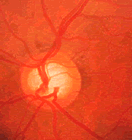|
GLAUCOMA
 Glaucoma is a group of diseases that can lead to damage
to the eyes optic nerve. The optic nerve is a bundle of more than
1 million nerve fibres and it connects the light-sensitive layer of
tissue at the back of the eye (retina), with the brain. A healthy
optic nerve is vital for good eyesight, any damage to it can lead
to blindness. Glaucoma is a group of diseases that can lead to damage
to the eyes optic nerve. The optic nerve is a bundle of more than
1 million nerve fibres and it connects the light-sensitive layer of
tissue at the back of the eye (retina), with the brain. A healthy
optic nerve is vital for good eyesight, any damage to it can lead
to blindness.
What causes Glaucoma?
The eye is filled with a watery liquid known as aqueous humour. The
aqueous humour which fills the front part of the eye is produced by
the ciliary body which sits just behind the iris. A series of sieve
like channels allow this fluid to be drained back into the bloodstream.
In a healthy eye the amount of fluid produced is balanced out by the
amount that is drained away, resulting in a constant pressure within
the eye.
A person suffering from Glaucoma can experience raised pressure
inside the eye which causes optic nerve damage. The rise in pressure
normally
occurs because the aqueous humour does not drain away properly due
to a dysfunctional drainage system. Poor blood supply and a weak
optic nerve have also been sited as causes of Glaucoma. People
at risk from
Glaucoma include:
| |
 |
 |
People who have suffered an eye injury or had eye
surgery |
 |
Anyone over the age of 60 |
 |
Diabetics, Heart Disease or other chronic condition
patients |
 |
African-Americans |
 |
Those with a family history of Glaucoma |
What are the symptoms?
Open-angle glaucoma is the most common type and has no symptoms in
the beginning. This is why it has been referred to as the ‘silent
thief’ of sight as the person with glaucoma is usually unaware
of it until serious loss of vision has occurred. There is no pain
and vision stays clear, though people may miss objects to the side
or corner of their eye.
If urgent treatment is not sought, side vision may disappear completely
and the sufferer may feel as though they are looking through a tunnel.
Over time this central vision may also reduce and render the person
blind. If any of the following symptoms become evident in your sight,
seek immediate advice from your GP:
|
 |
 |
Blurred or Loss of vision |
 |
Frequent change of glasses |
 |
Headaches or pain in the eyes |
 |
Seeing halos around lights |
What are the different types of Glaucoma?
The different types of Glaucoma are as follows:
• Open Angle Glaucoma – This is the most common type and occurs
when the eye’s internal drainage system becomes inefficient
or blocked over time, this then leads to a rise in aqueous humour
fluid which in turn increases the pressure within the eye. Usually
happens slowly without major symptoms and gradually affects vision
by which time the optic nerve may have been damaged. Hence regular
screening for those aged over 40 is advised.
• Closed Angle Glaucoma – Also known as Acute Glaucoma this condition
is less common. Involves the complete and sudden blockage of the drainage
system within the eye and can cause permanent blindness if not treated
urgently. The affected eye can become very painful and red. Immediate
treatment to reduce pressure in the eye is required along with treating
the other eye due to its chances of also developing the same condition.∑ Normal
Tension Glaucoma - Attributed to the poor rate of blood flow travelling
to the optic nerve in the eye which can results in vision loss. Interestingly
this can occur even when the pressure level within the eye is normal.
• Secondary Glaucoma – A
rare type of Glaucoma that is possibly caused by previous eye operations, diseases
or past injuries.
• Congenital Glaucoma – Another
uncommon Glaucoma which is caused by a physical abnormality of the eye usually
present at birth.
Glaucoma can be treated and controlled though not completely cured.
Early detection and diagnosis by testing pressure in the eye via a
painless tonometry test, are important if permanent damage to sight
is to be avoided. Depending on the type of Glaucoma the treatment
can include medicine, conventional surgery or laser surgery.
|



![]()


